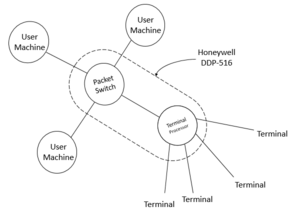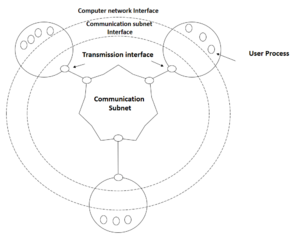NPL network facts for kids
The NPL network was an early computer network created by a team at the National Physical Laboratory (NPL) in London. This team was a pioneer in developing a new way to send data called packet switching.
The idea for the NPL network came from Donald Davies in 1965. Work on building it started in 1968. The first version, called Mark I, began working in 1969 and was fully ready by January 1970. A newer version, Mark II, ran from 1973 until 1986. The NPL network and the ARPANET in the United States were the first two computer networks to use packet switching. The NPL network was also the first to use very fast connections.
Contents
How the NPL Network Started
In 1965, Donald Davies, who later became the head of NPL's Computer Science division, suggested creating a national data network. This network would use his new idea of packet switching. Even though his national plan wasn't picked up, he led a team in 1966 to design a smaller, local network for NPL. This project aimed to show that packet switching could really work. Their design was the first to describe an "Interface computer," which we now call a router.
The next year, Roger Scantlebury presented the NPL network idea at a conference. He explained how computers (called nodes) would send small pieces of data (called packets). These nodes would be connected by electrical links to send the packets between them. Special interface computers would link these node networks to other computers and users. These interface computers could send many signals at once (multiplex). The nodes would switch these transmissions very quickly, at speeds of millions of bits per second. After the conference, Scantlebury noted that NPL's ideas seemed more advanced than anything proposed in the USA.
Larry Roberts used these ideas when designing the ARPANET. The NPL network first suggested a connection speed of 768 kbit/s. Because of this, ARPANET's planned speed was increased from 2.4 kbit/s to 50 kbit/s, and they used a similar packet format.
What is Packet Switching?
The idea of packet switching was first explored by Paul Baran. He suggested sending data in small pieces, which would travel independently through the network. This is similar to how a letter might be stored and then forwarded from one post office to the next. Donald Davies came up with the same idea on his own in 1965 and called it packet switching. He chose the word "packet" because it could be easily translated into other languages. Davies first showed packet switching to the public on August 5, 1968.
Building the Network
The NPL team used their packet switching idea to build an experimental network. They used a Honeywell 516 computer as a node. Interestingly, ARPANET also chose the same computer to be its Interface Message Processors. Construction of the NPL network began in 1968.
Parts of the first version, the Mark I NPL Network, started working in 1969. Leonard Kleinrock said this happened before ARPANET set up its first node. The network was fully working by January 1970. The NPL network, which was a local network, and the wide area ARPANET were the first two computer networks to use packet switching. The NPL network later used very fast T1 connections (1.544 Mbit/s), being the first computer network to do so. The Mark II version of the network started operating in 1973.
The NPL team also ran computer simulations to see how well packet networks would perform.
The NPL network was later connected to other networks, including the European Informatics Network (EIN) in 1976.
By 1976, 12 computers and 75 terminal devices were connected to the NPL network, and more were added over time. The network continued to operate until 1986. It greatly influenced other research in the UK and Europe.
Besides Donald Davies, the NPL team included Derek Barber, Roger Scantlebury, Peter Wilkinson, Keith Bartlett, and Brian Aldous.
Developing Network Rules
One of the first times the word "protocol" was used for data communication was in a paper written by Roger Scantlebury and Keith Bartlett in April 1967. A protocol is like a set of rules that computers follow to talk to each other. Another paper by Bartlett in 1968 introduced the idea of an "alternating bit protocol" (which ARPANET and EIN later used). It also described the need for three levels of data transmission. These levels are similar to the lower parts of the seven-layer OSI model that came out about ten years later. The Mark II version of the NPL network, which ran from 1973, used this "layered" protocol system. The NPL team also came up with the idea of "protocol verification," which means checking if the rules work correctly.
The NPL network was used to test ideas about connecting different networks together (called internetworking) throughout the 1970s. Davies, Scantlebury, and Barber were active members of the International Networking Working Group (INWG), which started in 1972. Vint Cerf and Bob Kahn thanked Davies and Scantlebury in their 1974 paper about network protocols. Derek Barber helped propose and lead the European Informatics Network (EIN) project, while Scantlebury led the UK's technical part. The EIN protocol helped start the INWG's work, which suggested an "international end-to-end protocol" in 1975.
NPL research looked into a big problem with connecting networks: if networks weren't designed to use the same rules, it would be hard to connect them. NPL connected with the European Informatics Network by translating between two different sets of rules. However, when NPL connected to the Post Office Experimental Packet Switched Service, they used the same rules for both networks. This work showed that using a common set of rules was more reliable and efficient.
Davies and Barber wrote important books about computer networks in 1973 and 1979. They spoke at a conference in 1975 about the "battle for access standards" between different ways of sending data (datagrams and virtual circuits). Barber said that the lack of standard rules for new public packet-switched networks was creating "some kind of monster" for users. For a long time, the network engineering community was divided over which set of rules to use, a period known as the Protocol Wars. It wasn't clear which type of protocol would create the best and strongest computer networks.
Davies' later research at NPL focused on making computer networks more secure.
Modern Recognition
NPL supports a special gallery that opened in 2009. This gallery is about the development of packet switching and the "Technology of the Internet." You can find it at The National Museum of Computing at Bletchley Park.
See also
- Coloured Book protocols
- History of the Internet
- Internet in the United Kingdom
- JANET
- UK Post Office Telecommunications and later British Telecommunications
- Telecommunications in the United Kingdom




